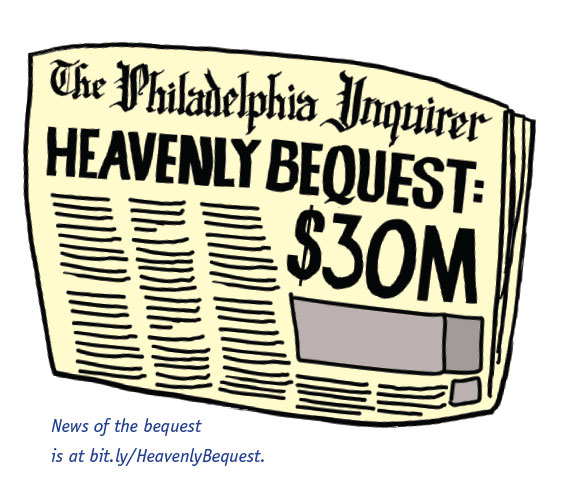 My first donor visit as a seminary chief executive was a stopover while moving from Chicago to assume the presidency at the Lutheran Theological Seminary at Gettysburg. Though I was not yet in office, I heeded the advice of my predecessor, Darold Beekman, to get acquainted with a couple who had shown deep appreciation for the seminary, and who seemed to have the capacity for significant gifts.
My first donor visit as a seminary chief executive was a stopover while moving from Chicago to assume the presidency at the Lutheran Theological Seminary at Gettysburg. Though I was not yet in office, I heeded the advice of my predecessor, Darold Beekman, to get acquainted with a couple who had shown deep appreciation for the seminary, and who seemed to have the capacity for significant gifts.
That first visit was memorable, as were all subsequent ones. I learned that “John” and “Jane,” who even in their final testamentary gifts insisted on anonymity, had given more than 40 years of professional service to their community. I learned that they had no children, and that Jane’s beloved father, then deceased, had been an alumnus of the seminary I was called to lead. While Jane remained a loyal and faithful member of her dwindling Lutheran congregation, John was proud in espousing his agnosticism. And while Jane’s primary charitable beneficiary was our seminary, John’s was his own alma mater.
Later, as I started collaborating with the seminary’s competent advancement staff, I struggled to share their confidence that Jane might leave a planned gift in the range of $5 million. And on many occasions over the following years, I confided to my colleagues: “I know about Jane’s love for the school and our mission, but every time I visit, we dine in a low-cost chain restaurant.” Her spirit of generosity was great, but her capacity seemed smaller than her enthusiasm.
In the latter years of my 17-year presidency at Gettysburg, I wondered if the fruits of our long-term cultivation with the couple would be realized during my tenure. After John’s death in his mid-80s, Jane spent her last years in a nursing home, where members of our advancement team and I continued to visit as often as we could. My confidence in Jane’s capacity for the projected $5 million estate gift was bolstered when she readily said “yes” to a request of $1.5 million for a special project that I knew was dear to her. But I fully expected that that much-needed special gift would diminish the ultimate proceeds from her estate.
When the time drew near for my retirement, which coincided with the Gettysburg–Philadelphia consolidation and the formation of United Lutheran Seminary, I made a final visit. I thanked Jane for our friendship and assured her that the newly unified seminary’s mission was aligned with that of the school that had shaped her father’s ministry.
A few months following my retirement and United Lutheran Seminary’s launch, word came of Jane’s death. She had been in her mid-90s. Weeks later, a courtesy call from a seminary executive began like this: “Michael, we’ve been informed Jane’s estate has bequeathed in excess of $30 million to the seminary for endowed student scholarships and a faculty chair.”
Insights from Jane’s and John’s story
As I ponder my own and my colleagues’ relationships with John and Jane, and the impact of their transformative gift — one of the largest ever received by a seminary — I offer the following takeaways:
1. St. Paul knew what he was talking about in terms of patience and teamwork. In 1 Corinthians 3:6 Paul writes: “I planted, Apollos watered, but God gave the growth.” While in some cases, short-term donor relationships may result in major gifts, the more typical pattern involves cultivation by multiple persons over a prolonged period. One of my mentors as a new president was my colleague at Lutheran Theological Southern Seminary, Fred Reisz. At an ELCA presidents’ gathering early in my tenure, Fred reminded us, “In these jobs, you’re always working for your successors.” In other words, many of the seeds we plant will not bear fruit until long after we leave office.
Most transformative gifts are the result of a long-term team effort. In the course of my presidency, we received a few large gifts (the largest was about $1.5 million) from donors with whom we had minor, if any, personal contact. But the typical transformative gifts are the result of relationship-building over many years. Jane’s stunning gift came after more than a quarter century, involving dozens of visits by two presidents and half a dozen vice presidents, as well as hundreds of on-campus conversations with deans, faculty members, trustees, and seminary administrators. All involved in cultivation should strive to undergird the donors’ love for and investment in the school’s mission (not loyalty to individuals currently in leadership).
2. The president and advancement team must be in sync. For donors at all levels, it’s critical that the senior leadership team be on the same page, seeking to discern individuals’ passions, determining the appropriate “ask” level, and thanking supporters for their generosity. The president and advancement personnel must work hand-in-hand, often making joint visits or tag-teaming to build donors’ confidence in the institution and its leadership.
3. Donors should be treated with respect, but loyalty to colleagues and the mission of the institution is vital. In any long-term relationship there will come times of friction and potential crises. About midway in my relationship with John and Jane, I learned that John had been offended by some offhand comments of one of our faculty members. After hearing the complaints, I challenged John’s assessment of the colleague and reminded him of the importance of freedom of expression in an academic institution. While I had some concern the conflict might jeopardize a major gift, I was unwilling to compromise core personal and institutional principles (or throw a colleague under the bus) for the sake of donor appeasement.
4. For every stunning gift there’s probably a missed opportunity. While the story of Jane’s transformative gift is amazing, some other long-term donor relationships proved deeply disappointing for me. Shortly after the death of her fellow congregant a few years ago, one of the Gettysburg trustees shared her belief that the friend’s estate would bring “the seminary” a gift of a million or more. When we heard nothing from the donor’s attorney for several weeks, I placed a call. The lawyer pulled the file, read for a moment, and then broke the news gently, “Yes, it’s right here — a seven-figure bequest to Seminary X, not Gettysburg.” It appears that in drafting his will the donor or his attorney was simply confused about seminary names. After licking my wounds for a few days, I was able — somewhat begrudgingly — to celebrate the donor’s generous gift to a worthy institution.
Those who embrace the vocation of leading seminaries in these tumultuous times, when the quest to raise the necessary resources is never ending, may get discouraged from time to time. Success cannot be guaranteed, for as St. Paul recognized, it comes only if and when God gives the growth. But the fundraising aspect of one’s calling is indeed a ministry, a holy calling in which the leaders of theological schools may find themselves inspired by the generosity of God’s faithful.




























